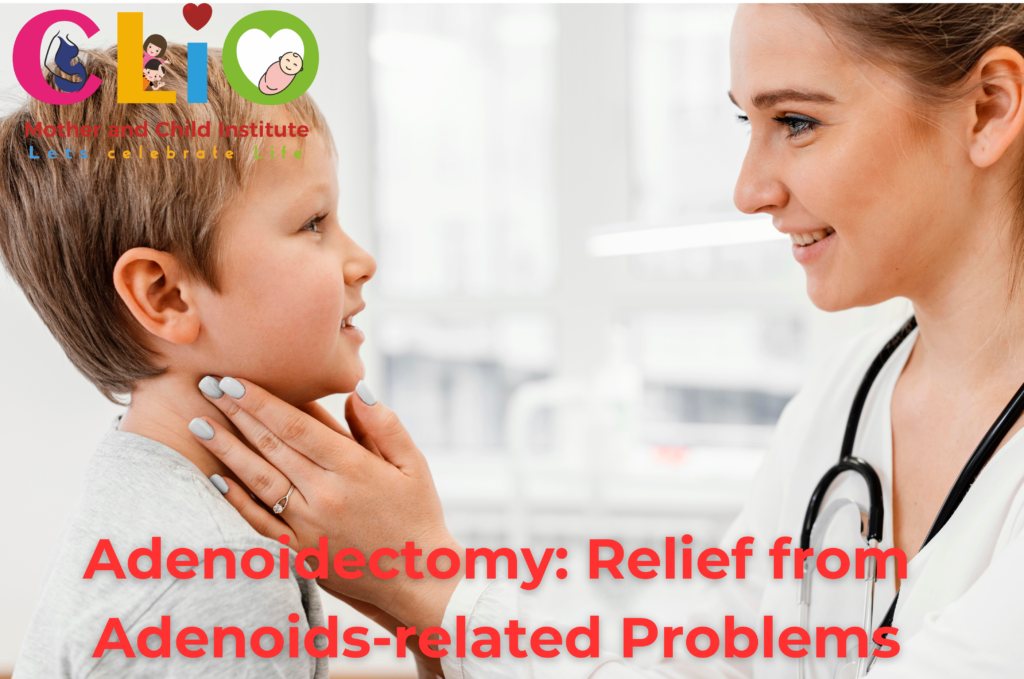When it comes to children’s health, ensuring their comfort and well-being is a top priority for parents. One common issue that many children face is problems related to the adenoids, which can significantly affect their quality of life. This blog delves into the procedure known as adenoidectomy, shedding light on how it can provide much-needed relief for children suffering from adenoid-related issues.
Understanding Adenoids and Their Role
Adenoids are small patches of tissue located at the back of the nasal cavity. They are part of the immune system and defend the body against infections by trapping harmful bacteria and viruses. In children, adenoids are more prominent and tend to shrink as they grow older. However, in some cases, the adenoids can become problematic.
Common Problems Associated with Adenoids
Enlarged Adenoids: One of the most common issues is the enlargement of adenoids. This condition, known as adenoid hypertrophy, can cause several symptoms, including difficulty breathing through the nose, snoring, and disrupted sleep. Children with enlarged adenoids may also experience recurrent ear infections and sinusitis.
Chronic Infections: When adenoids become chronically infected, they can cause persistent symptoms such as a sore throat, nasal congestion, and ear pain. This can lead to frequent doctor visits and a significant impact on a child’s daily activities and overall well-being.
What is an Adenoidectomy?
A surgical operation called an adenoidectomy is used to remove the adenoids. It is commonly recommended for children who have recurrent infections, significant breathing difficulties, or other complications related to enlarged or chronically infected adenoids. The goal of the surgery is to alleviate symptoms and improve the child’s quality of life.
The Adenoidectomy Procedure
Pre-Surgery Preparation: Before the surgery, a thorough evaluation is conducted, including a physical examination and possibly imaging tests. The surgeon will discuss the procedure, potential risks, and benefits with the parents. Parents need to follow all pre-surgery instructions, such as fasting requirements and medication guidelines.
During the Surgery: Adenoidectomy is typically performed under general anesthesia, ensuring that the child is asleep and pain-free during the procedure. The surgeon accesses the adenoids through the mouth, so there are no external incisions. The adenoids are then removed using specialized surgical instruments. The procedure usually takes about 30 minutes to an hour.
Post-Surgery Recovery: After the surgery, the child is monitored in a recovery room until the effects of anesthesia wear off. Most children can go home the same day. It is normal for the child to experience some throat pain, nasal congestion, and mild discomfort in the days following the surgery. Pain relief medications and proper hydration are essential during the recovery period.
Benefits of Adenoidectomy
Improved Breathing: One of the most immediate benefits of adenoidectomy is improved breathing. Children who previously struggled with nasal obstruction often experience significant relief, allowing them to breathe more comfortably through their nose.
Better Sleep: By alleviating breathing difficulties, adenoidectomy can lead to better sleep quality. Children with trouble sleeping due to snoring or sleep apnea often see improvements, resulting in more restful and restorative sleep.
Reduction in Infections: Removing the adenoids can reduce the frequency of ear and sinus infections. This means fewer antibiotic treatments, fewer doctor visits, and less disruption to the child’s daily life.
Enhanced Quality of Life: Overall, the procedure can significantly enhance a child’s quality of life. With improved breathing, better sleep, and fewer infections, children can engage more fully in activities, perform better in school, and enjoy a healthier, happier childhood.
Risks and Considerations
While adenoidectomy is generally considered safe, as with any surgery, there are potential risks and complications. These might include anesthesia-related side effects, hemorrhage, or infection. Parents must discuss these risks with the surgeon and understand the signs of potential complications during the recovery period.
Post-Surgery Care Tips
Pain Management: Over-the-counter pain relievers such as acetaminophen can help manage discomfort. It’s critical to adhere to the dose recommendations made by the medical professional.
Hydration and Nutrition: Encourage the child to drink plenty of fluids and eat soft, easy-to-swallow foods. Avoid giving them hot, spicy, or acidic foods that could irritate the throat.
Rest and Activity: Ensure the child gets plenty of rest during the initial recovery period. Gradually reintroduce regular activities as they feel better, but avoid strenuous activities for a few weeks.
Follow-Up Appointments: Attend all scheduled follow-up appointments to ensure the child is healing properly. The healthcare provider will monitor the recovery and address any concerns that may arise.
When to Seek Medical Attention
While complications are rare, it is important to know when to seek medical attention. Contact the healthcare provider if the child experiences excessive bleeding, persistent high fever, severe pain not relieved by medication, or signs of dehydration such as reduced urination or dry mouth.
Conclusion
Adenoidectomy can provide significant relief for children suffering from adenoid-related problems. By improving breathing, reducing infections, and enhancing overall quality of life, this procedure can make a substantial difference in a child’s health and well-being. If your child is experiencing symptoms related to enlarged or infected adenoids, consult with a healthcare provider to discuss the potential benefits of adenoidectomy.
At the CLIO Mother and Child Institute, we are committed to providing comprehensive care and support for families navigating health challenges. Our team of experienced professionals is dedicated to ensuring the best possible outcomes for your child’s health. If you have any questions or concerns about adenoidectomy or any other pediatric health issues, please do not hesitate to reach out to us. Our goal is to make your child’s life healthier and simpler to breathe.


